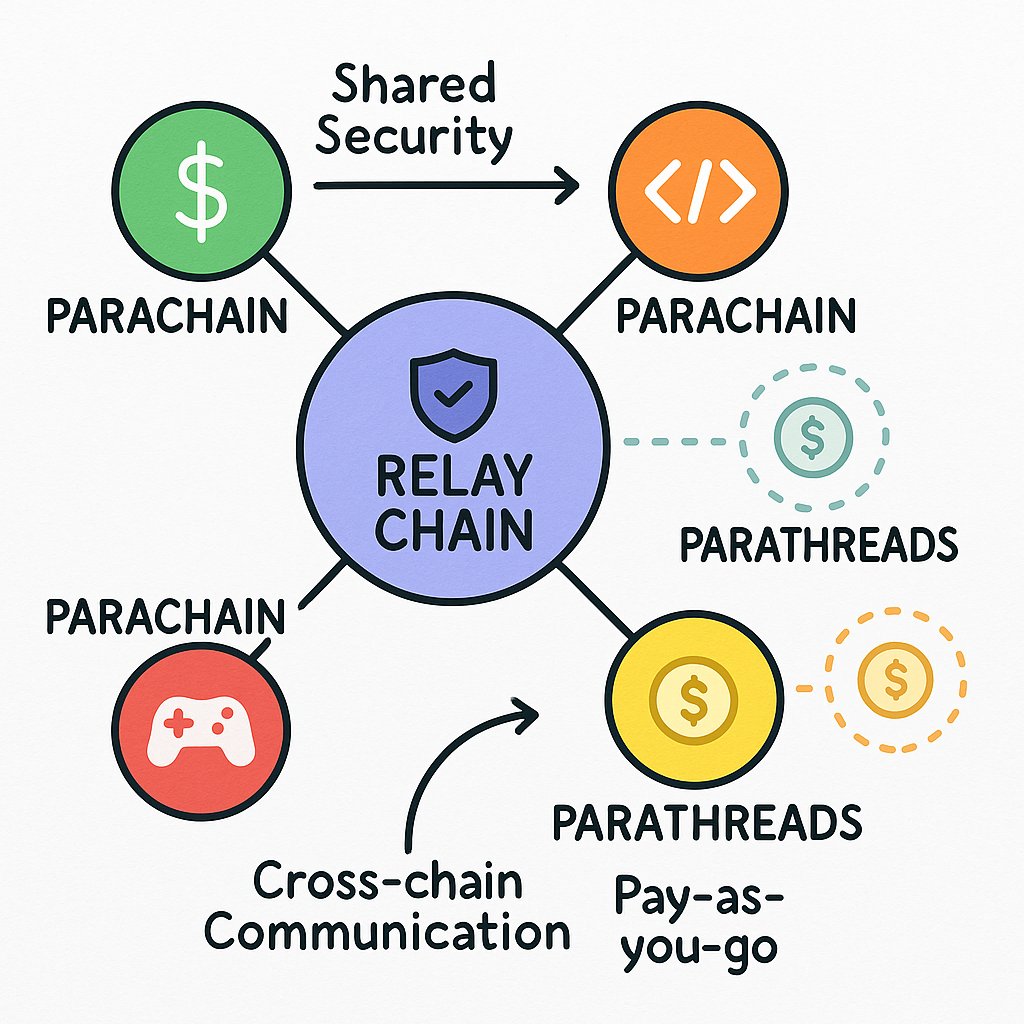[GUEST ACCESS MODE: Data is scrambled or limited to provide examples. Make requests using your API key to unlock full data. Check https://lunarcrush.ai/auth for authentication information.]  mrpicule.eth [@MrPicule](/creator/twitter/MrPicule) on x 9219 followers Created: 2025-07-18 14:19:56 UTC 🧵 Breaking down @Polkadot's multi-chain architecture and how it compares to @arbitrum Orbit 🔗 Relay Chain - The Security Hub The Relay Chain is Polkadot's central blockchain that coordinates the entire network. It handles: ✅ Shared Security: All parachains inherit the same security guarantees ✅ Cross-chain Communication: Enables message passing between parachains ✅ Consensus: Uses NPoS (Nominated Proof-of-Stake) for validator selection ✅ Governance: Network-wide decisions and upgrades Think of it as a "blockchain of blockchains" orchestrator ⚡ Parachains - Specialized Blockchains Parachains are independent blockchains that run in parallel on Polkadot: → Custom Logic: Each can have unique consensus, governance, and tokenomics → Substrate Framework: Built using Polkadot's blockchain-building toolkit → Auction System: Projects bid DOT tokens for 96-week parachain slots Examples: Acala (DeFi), Moonbeam (EVM), Astar (multi-VM) vs Arbitrum Orbit: Similar concept but Orbit chains are Ethereum L2s with EVM compatibility, while parachains can be completely custom blockchains 🔄 Parathreads - Pay-as-you-go Chains Parathreads offer a more flexible alternative to parachains: • On-demand: Pay only when you need block production • Lower Barrier: No need to win expensive parachain auctions • Temporary: Can upgrade to full parachain later • Perfect for: Lower-frequency applications, testing, or bootstrapping vs Arbitrum AnyTrust: Both offer cheaper alternatives to their main chains, but Parathreads are pay-per-block while AnyTrust uses a different security model 🔍 Key Difference: L1 vs L2 Philosophy Polkadot (L1): Creates sovereign blockchains with shared security Arbitrum Orbit (L2): Extends Ethereum with compatible scaling solutions Both are valid approaches to the multi-chain future! 🚀 Which approach do you prefer for multi-chain scaling: Polkadot's sovereign chains or Arbitrum's Ethereum-native L2s? 🤔 #Polkadot $DOT  XXX engagements  **Related Topics** [blockchain](/topic/blockchain) [Post Link](https://x.com/MrPicule/status/1946213352713118129)
[GUEST ACCESS MODE: Data is scrambled or limited to provide examples. Make requests using your API key to unlock full data. Check https://lunarcrush.ai/auth for authentication information.]
 mrpicule.eth @MrPicule on x 9219 followers
Created: 2025-07-18 14:19:56 UTC
mrpicule.eth @MrPicule on x 9219 followers
Created: 2025-07-18 14:19:56 UTC
🧵 Breaking down @Polkadot's multi-chain architecture and how it compares to @arbitrum Orbit
🔗 Relay Chain - The Security Hub
The Relay Chain is Polkadot's central blockchain that coordinates the entire network. It handles: ✅ Shared Security: All parachains inherit the same security guarantees ✅ Cross-chain Communication: Enables message passing between parachains ✅ Consensus: Uses NPoS (Nominated Proof-of-Stake) for validator selection ✅ Governance: Network-wide decisions and upgrades
Think of it as a "blockchain of blockchains" orchestrator
⚡ Parachains - Specialized Blockchains
Parachains are independent blockchains that run in parallel on Polkadot: → Custom Logic: Each can have unique consensus, governance, and tokenomics → Substrate Framework: Built using Polkadot's blockchain-building toolkit → Auction System: Projects bid DOT tokens for 96-week parachain slots
Examples: Acala (DeFi), Moonbeam (EVM), Astar (multi-VM)
vs Arbitrum Orbit: Similar concept but Orbit chains are Ethereum L2s with EVM compatibility, while parachains can be completely custom blockchains
🔄 Parathreads - Pay-as-you-go Chains
Parathreads offer a more flexible alternative to parachains: • On-demand: Pay only when you need block production • Lower Barrier: No need to win expensive parachain auctions • Temporary: Can upgrade to full parachain later • Perfect for: Lower-frequency applications, testing, or bootstrapping
vs Arbitrum AnyTrust: Both offer cheaper alternatives to their main chains, but Parathreads are pay-per-block while AnyTrust uses a different security model
🔍 Key Difference: L1 vs L2 Philosophy
Polkadot (L1): Creates sovereign blockchains with shared security Arbitrum Orbit (L2): Extends Ethereum with compatible scaling solutions Both are valid approaches to the multi-chain future! 🚀
Which approach do you prefer for multi-chain scaling: Polkadot's sovereign chains or Arbitrum's Ethereum-native L2s? 🤔 #Polkadot $DOT

XXX engagements
Related Topics blockchain